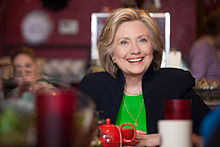Public image of Hillary Clinton
A 2006 survey by The New York Observer found "a virtual cottage industry" of "anti-Clinton literature", put out by Regnery Publishing and other conservative imprints, with titles such as Madame Hillary: The Dark Road to the White House, Hillary's Scheme: Inside the Next Clinton's Ruthless Agenda to Take the White House and Can She Be Stopped?
"[5] She has been the subject of many satirical impressions on Saturday Night Live, beginning with her time as first lady and has made guest appearances on the show herself, in 2008 and in 2015, to face-off with her doppelgängers.
[12] James Madison University political science professor Valerie Sulfaro's 2007 study used the American National Election Studies' "feeling thermometer" polls, which measure the degree of opinion about a political figure, to find that such polls during Clinton's first lady years confirm the "conventional wisdom that Hillary Clinton is a polarizing figure", with the added insight that "affect towards Mrs. Clinton as first lady tended to be very positive or very negative, with a fairly constant one fourth of respondents feeling ambivalent or neutral".
[13] University of California, San Diego political science professor Gary Jacobson's 2006 study of partisan polarization found that in a state-by-state survey of job approval ratings of the state's senators, Clinton had the fourth-largest partisan difference of any senator, with a 50-percentage-point difference in approval between New York's Democrats and Republicans.
"[17] Troy further wrote that Clinton "has been uniquely controversial and contradictory since she first appeared on the national radar screen in 1992" and that she "has alternately fascinated, bedeviled, bewitched and appalled Americans.
"[18] Burrell's study found women consistently rating Clinton more favorably than men by about ten percentage points during her first lady years.
[14] Colorado State University communication studies professor Karrin Vasby Anderson describes the first lady position as a "site" for American womanhood, one ready made for the symbolic negotiation of female identity.
[22][15] University of Pennsylvania communications professor Kathleen Hall Jamieson saw Clinton as an exemplar of the double bind, who though able to live in a "both-and" world of both career and family, nevertheless "became a surrogate on whom we projected our attitudes about attributes once thought incompatible", leading to her being placed in a variety of no-win situations.
[5] Quinnipiac University media studies professor Lisa Burns found press accounts frequently framing Clinton both as an exemplar of the modern professional working mother and as a political interloper interested in usurping power for herself.
[24] Going into the early stages of her presidential campaign for 2008, a Time magazine cover showed a large picture of her, with two checkboxes labeled "Love Her", "Hate Her",[25] while Mother Jones titled its profile of her "Harpy, Hero, Heretic: Hillary".
"[31] The "bitch" epithet, which had been applied to Clinton going back to her first lady days and had been seen by Karrin Vasby Anderson as a tool of containment against women in American politics,[33] flourished during the campaign, especially on the Internet but via conventional media as well.
[34] Following Clinton's "choked up moment" and related incidents in the run-up to the January 2008 New Hampshire primary, both The New York Times and Newsweek found that discussion of gender's role in the campaign had moved into the national political discourse.
[43] By September 2015, with her 2016 presidential campaign underway and beset by continued reports regarding her private email usage at the State Department, her ratings had slumped to some of her lowest levels ever.
In some formal settings, she used "Hillary D. Rodham", which appeared on her senior thesis,[49] in the transcript of her Wellesley graduation speech,[50] in reports of the United States House of Representatives investigation into the Watergate scandal,[51] and as chair of the Legal Services Corporation.
During the following winter, Vernon Jordan suggested to Hillary Rodham that she start using the name Clinton, and she began to do so publicly with her husband's February 1982 campaign announcement to regain that office.
Sidney Johnson, president of the Arkansas Education Association, said of the couple that "[s]omething would come down and you wouldn't know which one of them thought of it, where Bill stopped and Hillary began.




